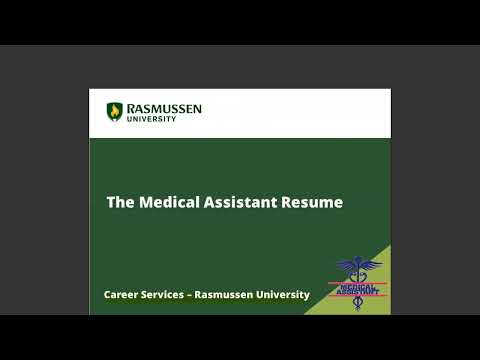What Do Medical Assistants Do?
Contents
Medical assistants are in high demand! They provide valuable support to doctors and other medical staff, performing a variety of tasks. If you’re thinking of becoming a medical assistant read on to learn more about what they do.
Checkout this video:
Job Description
Medical assistants perform a variety of duties to support the work of physicians and other health professionals. They typically take medical histories, help patients understand their health problems, provide medications and other treatments, schedule appointments, arrange for hospital admissions and laboratory services, and perform routine office tasks. Some medical assistants specialize in areas such as optometry, podiatry, or orthopedics.
Duties and Responsibilities
The duties and responsibilities of medical assistants vary from state to state and from one employer to another. In general, medical assistants perform both clinical and administrative tasks in doctors’ offices, hospitals, outpatient clinics, and other healthcare facilities.
Clinical duties may include taking and recording patients’ vital signs, updating their medical histories, explaining treatment procedures to them, preparing them for examinations, assisting the physician during examinations, and collecting and processing laboratory specimens. Administrative duties may include scheduling appointments, verifying insurance coverage, handling correspondence, handling billing and coding information for insurance purposes, maintaining medical records handling telephone calls, ordering supplies, and keeping the office organized.
In small offices, medical assistants may be responsible for a wide range of tasks. In larger offices or clinics, they may be asked to specialize in either clinical or administrative duties. Some medical assistants are certified to perform both types of tasks.
Skills and Qualifications
Skills and Qualifications
In order to be a successful medical assistant you will need to have certain skills and qualifications.
First and foremost, you should be compassionate and have excellent people skills. As a medical assistant, you will be interacting with patients on a daily basis. It is important that you are able to put them at ease and make them feel comfortable. You should also be able to clearly communicate with both patients and staff. Strong written and verbal communication skills are essential in this role.
You should also be detail-oriented and organized. Medical assistants are responsible for maintaining patient records, scheduling appointments, and handling insurance paperwork. This can be a lot of work, so it is important that you are able to stay organized and keep track of multiple tasks at once.
In addition to these soft skills, there are also some hard skills you will need to succeed in this role. Medical assistants should have basic medical knowledge so that they can assist the doctor during examinations, take patient medical histories, and measure vital signs. You will also need to know how to use common medical equipment such as blood pressure cuffs and stethoscopes.
While most employers will provide on-the-job training, it is still beneficial to have some formal education under your belt. Many medical assistants have completed a certificate or associate’s degree program from an accredited school. These programs typically last between one and two years, and they cover topics like anatomy, physiology, Medical Terminology administrative procedures, and computer applications
Education and Training
Most medical assistants have postsecondary education such as a certificate. Some programs take as little as 1 month to complete, but most last between 2 and 3 months. A few community colleges offer associate’s degree programs in medical assisting, which typically take 2 years to complete.
Certification
Medical assistants can become certified through an accredited program. Once they have completed a training program, they must then pass an exam to receive their certification.
There are two main types of medical assistant certification: the Certified Medical Assistant (CMA) and the Registered Medical Assistant (RMA). In order to become a CMA, medical assistants must complete an accredited training program and pass the CMA Exam. To become an RMA, medical assistants must pass the RMA Exam. There is no requirement to complete an accredited training program, but many choose to do so.
Salary and Job Outlook
The median pay for medical assistants in 2018 was $17.31 per hour, or $36,010 annually, according to the U.S. Bureau of Labor Statistics (BLS). The top 10% of earners made more than $23.62 per hour, or $49,170 annually, while the bottom 10% of earners made less than $11.65 per hour, or $24,270 annually.
BLS data from 2018 shows that employment for medical assistants is expected to rise by 29% from 2018 to 2028—much faster than the average for all occupations—adding about 731,800 new jobs during that time frame. The growth is due in large part to an aging Baby Boomer population and an increasing emphasis on preventive care and early detection of disease.
Working Conditions
Medical assistants work in physicians’ offices, hospitals, clinics, and other healthcare facilities. They might work behind the scenes in administrative capacities or interact directly with patients. They generally work full time, although some have part-time jobs. Many medical assistants work evenings or weekends to accommodate patients’ schedules.
Career Paths
Medical assistants are integral members of the healthcare team. They perform a variety of administrative and clinical tasks to keep the offices of physicians, podiatrists, chiropractors, and other health practitioners running smoothly. Most medical assistants have postsecondary education such as a certificate or an associate’s degree.
Medical assistants must be able to perform both clerical and clinical duties. The specific duties of medical assistants vary from state to state and from one medical practice to another. However, there are some duties that are common to most medical assisting jobs. These include:
-Answering phones
-Scheduling appointments
-Greeting patients
-Updating and filing patients’ medical records
-Taking and recording patients’ vital signs
-Preparing examination rooms
-Assisting with procedures performed by physicians and other healthcare practitioners
-Instructing patients about medications, diet, and other aspects of their care
With experience, medical assistants may assume additional responsibilities, such as billing insurance companies or handling financial matters for the practice. In smaller practices, medical assistants may take on more clerical duties; in larger practices they may do more laboratory work or specialize in a particular area such as geriatrics or pediatrics.
Job Opportunities
Job opportunities in the medical assisting field are expected to be good. Employment of medical assistants is projected to grow 19 percent from 2019 to 2029, much faster than the average for all occupations. An aging population and increasing demand for preventive medical services will lead to more demand for healthcare services.
Medical Assistant Job Resources
Medical assistants are an important part of the healthcare team. They work closely with physicians and other medical staff to provide patient care and perform administrative tasks.
Medical assistants must have excellent communication skills and be able to effectively multitask. They must be able to work well under pressure and maintain a professional demeanor at all times.
If you are interested in becoming a medical assistant, there are many resources available to help you get started. The following websites offer job descriptions, salary information, and career resources for medical assistants:
-American Association of Medical Assistants: https://www.aama-ntl.org/medical-assistant-jobs
-Bureau of Labor Statistics: https://www.bls.gov/ooh/healthcare/medical-assistants.htm
-Medical Assistant Education Association: https://maeaorg.memberclicks.net/medical-assistant-jobs






